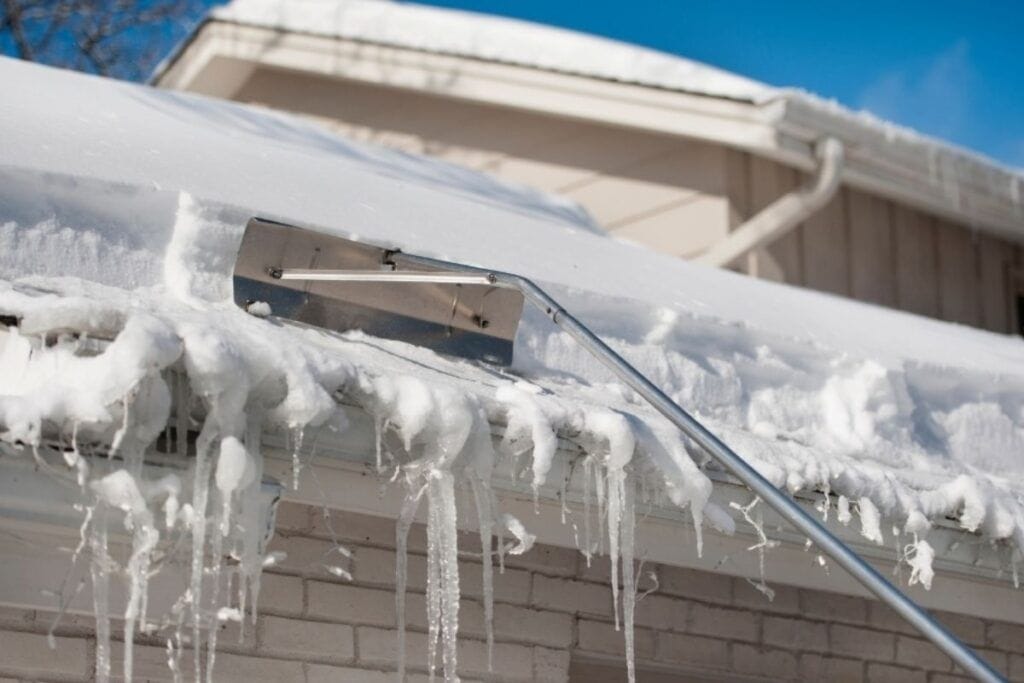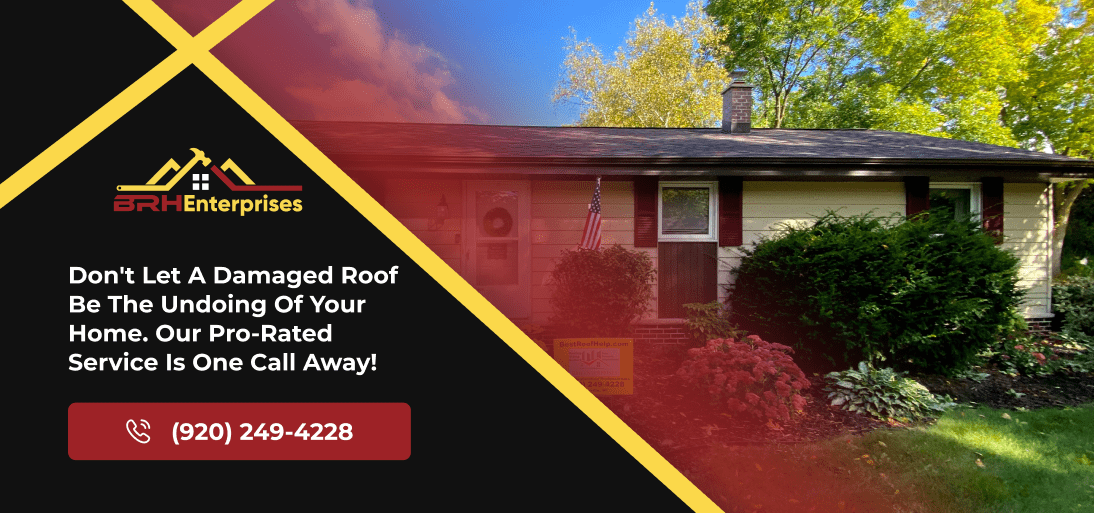How Ice Dams Can Affect Your Wisconsin Home
Estimated Reading Time : 6 Min.

Ice dams can affect homes in Wisconsin in numerous ways. In fact, they can be the reason for a roof collapse. If you want to know the effects of ice dams on your roof and how you should prevent them from happening, you’re on the right page. This blog post will explain what causes ice dams on roofs in Wisconsin and give you some tips to safely remove them.
A Glance At Winters In Wisconsin
1. Cold Temperatures
Wisconsin, as we all know, experiences cold winters, with temperatures often dropping below freezing. Temperatures during the winter months, especially in December, January, and February, typically range from 25° F to 5° F.
2. Snowfall
Snowfall is a common feature of Wisconsin winters. The state receives a significant amount of snowfall, particularly in the northern and western regions. Snow can start falling as early as November and can continue through March or even April in some areas.
What Are Ice Dams On Roofs?

Ice damming is a common issue in snowy regions. Ice dams are the thick packs of snow and ice that build up on the edge of the roof. If you see icicles hanging over the roof’s edge, there is probably snow covering your roof. Ice dams can cause damage to roofs and can danger the occupants living underneath.
Moreover, many factors contribute to ice dams on roofs, and of them, an uneven temperature throughout the roof is the most common cause.
What Causes Ice Dams On Roofs?
1. Non-Uniform Roof Surface Temperature
Inconsistent surface temperature across the roof is one of the main causes of ice dams. Since hot air rises to the highest level of a building and pushes up on the roof, it melts the snow sitting on the roof, causing it to flow towards the gutters, where, because of the relatively low temperature, it refreezes again and piles up in layers.
2. Poor Roof Insulation
The roof insulation is meant to trap the building’s heat within and prevent it from escaping outside. Functional roof insulation will balance indoor temperatures and therefore will maintain the home’s integrity. If the roof insulation loses its effectiveness, the heat from the building will escape, causing snow to melt, which becomes a prime reason for ice damming in winter.
Also Read: All You Need To Know About Roof Insulation And The Top Products In Just 5 Minutes
3. Solar Radiation
Solar radiation can also contribute to ice dam formation. On sunny days, the sun’s heat can melt snow on the upper part of the roof, and the melted water will flow down and refreeze at the eaves once the sun sets and temperatures drop at night.
Too much ice damming on roofs can be problematic for the roofing structure, the home, and the residents living there. It can abruptly slide down the roof and damage plants, the yard, and harm the people walking alongside the home.
Effects of Ice Dams On Your Wisconsin Home
1. Roof Damage
Ice dams on the roof block the path of the melting water and prevent it from reaching the gutters and the drainage system. The blocked water can seep into the roofing material and cause significant roof damage if it passes through the underlayment and into the roof deck.
2. Interior Water Damage
When water from melting snow and ice backs up behind the dam, it can find its way into the home through gaps in the roof and around vents. This can result in water damage to ceilings, walls, insulation, and even electrical systems.
3. Mold and Mildew Growth
Wet and damp surfaces are a breeding ground for mold and mildew. Once their spores settle on any wet surface, they grow quickly, spreading to a larger area. Mold growth not only damages your home’s structure, but also poses health risks to occupants.
Also Read: The Best Time To Remove Moss From Your Roof
4. Ineffective Insulation
Ice dams can compromise the insulation in your attic. If water seeps into the attic and insulation, it reduces its effectiveness. This can lead to increased energy bills as your heating system works harder to maintain a comfortable temperature.
5. Gutter and Downspout Damage
Since the ice dams form around the gutters, they add more weight to the drainage system. The added weight of ice dams can damage gutters and downspouts, causing them to pull away from the roofline or even fall off. This can lead to additional issues with water runoff.
6. Icicle Formation
One of the telltale signs of ice dams occurring is finding icicles hanging under the roof’s edge. While icicles can look beautiful, they can be dangerous and may cause injury or property damage if they fall.
How To Remove Ice Dams From Your Roof
The following ways can help you remove ice dams from your roof safely and effectively.
1. Roof Raking

A roof rake is a long handled tool that you can use to remove the snow from the top of your roof while standing on the ground. This is a preventive measure to remove the snow on the roof before it turns into ice dams. The roof rake can help reduce the chances of ice dams forming in the first place. However, be cautious while removing snow from the roof, as any mistake can cause roofing shingles to be damaged or removed completely.
2. Calcium Chloride or Ice Melt
You can use calcium chloride or another ice melt product to create channels through the ice dam, allowing trapped water to escape. Here’s how to do it:
- Fill a pair of pantyhose or a sock with calcium chloride or ice melt.
- Place the filled stockings perpendicular to the roof’s edge, creating a zigzag pattern on the ice dam.
- This will melt channels through the ice, allowing water to drain off the roof.
- Do not use rock salt, which can damage your roof and surrounding vegetation.
3. Steam
Ice dam steamers are an effective and safe method to remove ice dams, but they are a piece of specialized equipment. Professionals use steam machines to melt the ice and then carefully remove it with a roof shovel or similar tool.
4. Roof Shovel
If you decide to use a roof shovel, exercise extreme caution to avoid damaging the shingles or your roof. Start from the edge of the roof and carefully work your way up, removing snow and ice as you go. Do not use a regular shovel or metal tools, as they can damage your roof.
How You Can Prevent Ice Damming On Your Roof
Do you want to permanently stop ice dams from occurring on your roof? The following steps can help you:
1. Improve Attic Insulation
As said earlier, proper attic insulation maintains a consistent and balanced temperature on your roof. It prevents hot spots and keeps the temperature the same throughout the roof. If the insulation loses its efficiency, it allows heat to escape the building and can cause major problems like ice damming. Ensure that you have sufficient insulation installed properly in your attic.
2. Enhance Attic Ventilation
Roof ventilation and insulation work in combination. While roof vents maintain a consistent airflow within the attic, the roof insulation maintains interior temperatures.
Adequate attic ventilation helps regulate temperature and moisture levels. Make sure your attic has proper soffit and ridge vents to allow air to flow through, preventing warm air from accumulating and melting snow on the roof.
3. Seal Air Leaks
Identify and seal any gaps, cracks, or air leaks in your attic. Common sources of air leaks include gaps around pipes, vents, and light fixtures. Use caulk, weatherstripping, or foam insulation to seal these areas.
4. Install Snow Guards
Installing snow guards on the roof is another permanent preventive method of stopping ice dam formation. Snow guards are installed on the roof to break up and prevent large sheets of snow and ice from sliding off suddenly. This can reduce the risk of injury and property damage caused by falling ice and snow.
5. Heat Cables or Roof De-Icing Systems
Install heat cables or electric roof de-icing systems in problem areas of your roof, such as the eaves. These systems can help melt snow and ice to prevent the formation of ice dams.
Do You Need Professional Assistance In Removing Ice Dams on Your Roof?
Roofing professionals can easily handle removing any ice dams on your roof. And since removing ice dams can be a risk for first-time DIYers, it’s important to seek professional assistance. If you also want to minimize the effects of ice damming on your home in Wisconsin, contact BRH Enterprises, your local area roofing company.
We have the best and most skilled roofers ready to assist home and business owners on any roofing project. Whether you need roof damage repair, a complete roof replacement, or a new roof installation, we provide remarkable roofing services for all Wisconsin homeowners. Just give us a call at (920) 249-4228 and consult a professional for your roofing needs.


